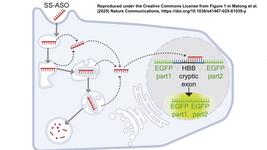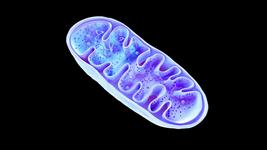CMN Weekly (28 December 2022) - Your Weekly CRISPR Medicine News
By: Gorm Palmgren - Dec. 28, 2022
Top picks
- American researchers have studied online and television news sources in the United States to determine the tone, content, and frequency in media coverage of CRISPR. They find that coverage remained ambiguous and infrequent as scientific research into CRISPR's clinical potential for treating human disease surged. This rare coverage indicates that the media still need to establish the salience of CRISPR to the degree that engages the public or policymakers. However, the issue will continue to gain importance as CRISPR transitions from experimental efforts into clinical practice.
- Chinese researchers have used probiotic Lactobacillus with an electrostatically attached and ultrasound-controlled CRISPR-Cas9 system for a gene editing therapy of solid cancer tumours. The system exploits the ability of Lactobacillus to both activate the immune system and colonise the hypoxia tumour centre. When the target is reached, ultrasound releases and activates the CRISPR-Cas9 knockdown of the indoleamine 2,3-dioxygenase-1 (IDO1) gene. As a result, immunogenic cell death is amplified, and tumour immunosuppression is reversed. Furthermore, the system generates immune responses that effectively attack tumour cells in mice, contributing to the inhibition of tumour re-challenge in vivo.
Research
- American researchers have established a pipeline for creating an engineered CRISPR-Cas12a with improved genome editing capabilities by combining structural insights with randomisation and selection. The engineered and evolved mutants had enhanced ability to induce homology-directed repair (HDR) editing by 2–18-fold compared to wild-type Cas12a and had superior genome editing efficiency at genomic sites that are difficult to edit using wild-type Cas12a.
- Danish researchers have demonstrated that the histone methylation inhibitor 3DZNep promotes HDR pathway choice during CRISPR-Cas9 genome editing. Non-homologous end joining mediated repair, on the other hand, was not significantly changed, and the HDR-promoting effect was largely independent of the target gene and its expression levels but showed a limited cell type specificity.
- In a mouse model of age-related macular degeneration (AMD), Chinese researchers have demonstrated that an engineered version of Cas9 can almost eliminate chromosomal translocations at a frequency of approximately 1% in normal Cas9-edited mouse retinal cells. The engineered Cas9TX was fused to three prime repair exonuclease 2 (TREX2) and used to disrupt the Vegfa gene by AAV delivery.
- Researchers in Denmark have achieved highly efficient (98%) and biallelic CRISPR knockout of the hypoxia-inducible factor 1-alpha (HIF1A) gene in human umbilical vein endothelial cells (HUVECs) without selection. The CRISPR system was delivered through nucleofection, and the effects of HIF1A knockout on epithelial cells' angiogenic characteristics and response to hypoxia were validated by functional assays.
- CRISPR-Cas9 with gRNAs targeting an expanded CAG repeat in the huntingtin (HTT) gene shows promise as a therapy for Huntington’s disease (HD) in an in vitro mouse model. Editing of CAG repeat sequences decreases polyglutamine aggregation and cellular apoptosis. This may be related to the confirmed upregulation of peroxisome proliferator-activated receptor gamma coactivator-1 alpha (PGC-1α) and brain-derived neurotrophic factor (BDNF).
- A direct comparison of SpCas9 from Streptococcus pyogenes and SaCas9 from Staphylococcus aureus finds that SaCas9 is superior to SpCas9 in transgene integration-based therapeutic gene editing. The authors characterised the editing outcomes of 11 sites in human induced pluripotent stem cells (iPSCs) and K562 cells. They found that SaCas9 could edit the genome with greater efficiency than SpCas9. Furthermore, the two nucleases were found to have different optimal spacer lengths of 20 nt and 21 nt for SpCas9 and SaCas9, respectively.
Industry
- SNIPR Biome further strengthened its CRISPR-Cas IP portfolio after the USPTO granted the company a patent that covers the use of CRISPR-Cas systems to achieve selective killing of bacteria by at least 1000-fold in situations where bacteria are growing in a mixed population. This patent covers the use of any type of CRISPR-Cas. In addition, SNIPR has received an allowance from the USPTO indicating that it will shortly grant a US patent broadly covering methods of using CRISPR lytic phage by use of any CRISPR-Cas system and for any application.
Detection
- Chinese researchers have developed an assay based on CRISPR-Cas13a and catalytic hairpin assembly (CHA), termed Cas-CHA, for the ultrasensitive and specific detection of SARS-CoV-2 RNA. Upon specific recognition of the target, the CRISPR/Cas13a collaterally cleaved a well-designed hairpin reporter and triggered the CHA reaction. Under optimised conditions, the assay detected the SARS-CoV-2 RNA with a wide range of 100 aM to 100 nM and realised a low detection limit of 84 aM within 35 minutes.
- Researchers in China report a metal-organic framework (MOF)-based DNA bio-barcode integrated with the CRISPR/Cas12a system for ultrasensitive detection of protein biomarkers. Zirconium-based MOF nanoparticles were co-modified with antibodies and bio-barcode phosphorylated DNA as an efficient signal converter. These modifications recognised the protein biomarker to form the sandwich complex and released the bio-barcode DNA activators after MOF dissociation to activate the trans-cleavage activity of Cas12a.
- Chinese researchers describe a rapid and high-throughput detection system for Helicobacter pylori nucleic acid. The system uses isothermal recombinase polymerase amplification (RPA) and CRISPR-Cas12a to detect the UreB gene with a limit of detection of 50 and 100 copies using fluorescence or lateral flow dipstick detection, respectively.
- Another detection system for Helicobacter pylori uses PCR amplification and collateral activation of CRISPR-Cas13a for fluorescence detection. The PCR-Cas13a detection system demonstrated 98% sensitivity and 100% specificity and had a lower limit of detection of 2.2 copies/μL within 30 mins after PCR amplification.
- Chinese researchers describe a ratiometric fluorescent biosensor for rapidly detecting Burkholderia pseudomallei (Bp) by dual CRISPR-Cas12a trans-cleavage assisted signal enhancement. Melioidosis caused by Bp infection has high mortality in tropical and subtropical regions.
- Researchers in China have established a system for rapid and ultra-sensitive early detection of cervical cancer using CRISPR-Cas12 based on methylated SEPT9. Methylated SEPT9 is a specific biomarker for the early diagnosis of cervical cancer, and the assay can detect one copy/μL of mSEPT9 and distinguish 0.01% mSEPT9 from large amounts of gDNA.
Reviews
- Researchers from Iran discuss the numerous gene delivery, gene editing, and stem cell manipulation techniques used to treat familial hypercholesterolemia (FH) in vitro, ex vivo, and in vivo. The main focus is on correcting variations in the low-density lipoprotein receptor (LDLR) with the CRISPR-Cas9 gene editing technology.
- South Korean researchers examine recent developments in three distinct types of biosensors for healthcare: biosensors for in vitro diagnosis with blood, saliva, or urine samples; continuous monitoring biosensors (CMBs); and wearable biosensors. The authors discuss how CRISPR-Cas methodologies have expanded and improved many established integrated biosensor devices, including lateral flow assays (LFAs) and microfluidic/electrochemical paper-based analytical devices (μPADs/ePADs).
- Chinese researchers review the challenges, strategies, and perspectives of amplification-free CRISPR-Cas detection technologies. The authors highlight the four main approaches to promote the performance of target amplification-free CRISPR/Cas-based technology and discuss future perspectives that will contribute to developing more efficient amplification-free CRISPR-Cas detection systems.
To get more of the CRISPR Medicine News delivered to your inbox, sign up to the free weekly CMN Newsletter here.
Tags
CLINICAL TRIALS
IND Enabling
Phase I
Phase II
Phase III
Recurrent or Progressive High-grade Glioma, (NCT06737146)
Sponsors:
Suzhou Maximum Bio-tech Co., Ltd.
Sponsors:
Suzhou Maximum Bio-tech Co., Ltd.
IND Enabling
Phase I
Phase II
Phase III
Advanced Peritoneal Malignancies or Abdominal Metastatic Solid Tumors, (NCT06912152)
Sponsors:
Zhejiang University
Sponsors:
Zhejiang University
IND Enabling
Phase I
Phase II
Phase III







